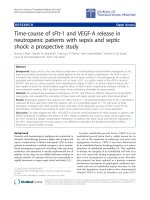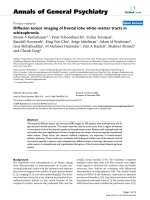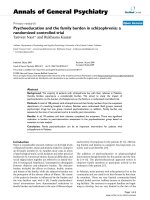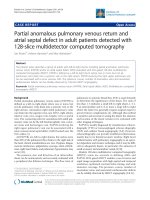Gray and white matter reduction in schizophrenia patients
Bạn đang xem bản rút gọn của tài liệu. Xem và tải ngay bản đầy đủ của tài liệu tại đây (256.69 KB, 6 trang )
TẠP CHÍ Y - DƢỢC HỌC QUÂN SỰ SỐ CHUYÊN ĐỀ HÌNH THÁI HỌC-2017
GRAY AND WHITE MATTER REDUCTION IN
SCHIZOPHRENIA PATIENTS
Dang Tien Truong*; Nguyen Duy Bac*; Tran Ngoc Anh*; Tran Hai Anh*
SUMMARY
Objectives: Brain structure changes in schizophrenia (SZ) have been a focus for recent
decades. Yet such researches, especially those on gray and white matters in Vietnamese SZ
patients, still parsimonious. The present study concerned changes of brain structures including
gray and white matters in SZ. Subjects and methods: Participants included 39 patients with SZ
and 40 healthy control individuals, they were underwent 1.5 tesla MRI. Automated segmentation
of brain structures was performed using FreeSurfer software. Results: There was a significant
reduction in total brain with ventricles, total brain with ventricles/ICV ratio, total brain without
ventricles, and gray and white matters in SZ patients, but an enlargement of ventricles
comparing to those in controls. Conclusion: Our results of MRI study in Vietnamese people
support a notion of the reduction of gray and white matters and of brain volume in SZ.
* Keywords: Schizophrenia; MRI; Brain structure.
INTRODUCTION
Schizophrenia is a mental disorder with
variations in symptoms and pathophysiology,
but its etiology still remains largely unclear
[1]. The disease is characterized by
alterations in cognition, motivation, memory,
and social communications. Research
interest in investigating brain abnormalities
in SZ thus paled until 1976, when the first
computed tomography showed enlarged
lateral ventricles in SZ and magnetic
resonance imaging (MRI) studies followed
[12]. MRI has been a powerful tool for
visualizing soft tissue contrast in the brain
and no known adverse effects. Hence,
there have been a plentiful number of
studies using MRI with higher resolution
[2, 3], which report morphologic
abnormalities of the brain in SZ [5, 7], the
correlation of symptoms and brain
changes [5, 6, 11], and between cognitive
functions with gray matter (GM) [9, 10]
and white matter (WM) [6, 12].
In Vietnam, most among numerous
studies on SZ have concentrated on its
epidemiological and/or clinical aspects,
and still few those concerned its pathology
(such as serotonin level in SZ patients) or
brain morphology in SZ, but no studies
reported for GM and WM. This report
showed findings on volumes of the whole
brain/cranium and regions generally, and
GM and WM in SZ specifically.
SUBJECTS AND METHODS
1. Subjects.
39 schizophrenic patients and 40 healthy
controls were recruited in the research,
they were all right-handed. SZ cases were
collected from Department of Psychiatry,103
Hospital, Vietnam Military Medical University.
* Vietnam Military Medical University
Corresponding author: Tran Hai Anh ()
Date received: 30/07/2017
Date accepted: 09/09/2017
656
TẠP CHÍ Y - DƢỢC HỌC QUÂN SỰ SỐ CHUYÊN ĐỀ HÌNH THÁI HỌC-2017
The SZ patients were diagnosed by
criteria of Diagnostic and Statistical Manual
of Mental Disorders, 4th Edition (DSM-IV),
confirming by two independent psychiatrists.
All patients had no second psychiatric
condition. All healthy controls had no
history of psychiatric disorder, current
psychiatric disorder, neurological or other
significant medical disorders potentially
influencing neurocognitive function, and
first-degree relatives with psychiatric
disorders according to DSM-IV.
automated
transformation,
segmentation of the subcortical WM and
deep GM, volumetric structures intensity
normalization, tessellation of the GM and
WM boundary, automated topology correction,
and surface deformation following intensity
gradients to optimally place the gray/white
and gray/cerebrospinal fluid borders at
the location where the greatest shift in
intensity defines the transition to the other
tissues. Once the cortical models were
completed,
2. Methods.
Talairach
a number of
deformable
procedures can be performed for further
* MRI acquisition:
data processing and analyzing including
The MRI scans were acquired on a
1.5T system, using a three-dimensional
spoiled gradient echo sequence according
to the following protocol: 1 mm sagittal
slices with TR = 15 ms, TE = 5 ms, Flip
angle = 30°, FOV = 256, Matrix = 256 x
256. Scans were inspected for motion
artifacts and a neuroradiologist confirmed
absence of gross pathological findings.
* MRI scan processing and calculation
of morphological brain:
surface inflation, registration to a spherical
atlas which is based on individual cortical
folding
patterns
to
match
cortical
geometry across subjects [3], parcellation
of the cerebral cortex into units with
respect to gyral and sulcal structure [3, 4],
and creation of a variety of surface based
data including maps of curvature and
sulcal depth.
* Statistical analysis:
We used FreeSurfer software package
Volumes of brain regions were calculated
(version 5.3.0, )
and compared using a student t-test.
for processing images. The technical
The volumes were compared further in
details of these procedures are described
subgroups by genders of participants.
elsewhere in prior publications [3, 8].
Demographic data were compared using
Briefly, the image processing includes
a Chi-square test.
motion
correction
and
averaging
of
* Ethical approval:
multiple volumetric T1 weighted images,
This study was approved by the ethics
removal of non-brain tissue using a hybrid
review committee of Vietnam Military Medical
watershed/surface deformation procedure,
University.
657
TẠP CHÍ Y - DƢỢC HỌC QUÂN SỰ SỐ CHUYÊN ĐỀ HÌNH THÁI HỌC-2017
RESULTS AND DISCUSSION
1. Demographics of participants.
Table 1: Demographic characteristics of SZ patients and controls.
Age
Groups
(
Gender (n, %)
± SD)
Male
Female
SZ
32.74 ± 10.13
26 (54.17)
13 (40.63)
Control
34.54 ± 11.64
22 (45.83)
19 (59.38)
p = 0.46
p = 0.23
The results in table 1 showed that SZ patients did not differ from controls regarding
age and gender.
2. Volumes of brain regions in SZ and control groups.
Table 2: Volumes of brain regions in SZ and control groups.
SZ (n = 39)
Control (n = 40)
Volume
p
(
± SD)
(
± SD)
1153.40 ± 111.56
1208.51 ± 108.51
0.028a
Total brain with ventricle/ICV
0.78 ± 0.06
0.80 ± 0.03
0.037b
Total brain without ventricle
1131.59 ± 108.04
1191.95 ± 109.59
0.015a, b
2.21 ± 2.23
2.33 ± 2.58
0.013a
Total cerebellum
108.66 ± 12.90
111.73 ± 10.25
0.24
Left cerebellum
53.41 ± 5.95
54.72 ± 4.99
0.29
Right cerebellum
55.25 ± 7.07
57.01 ± 5.41
0.21
Lateral ventricle
14.67 ± 5.97
11.07 ± 6.62
0.012b
Left lateral ventricle
8.03 ± 3.26
5.88 ± 3.46
0.005a, b
Right lateral ventricle
6.64 ± 2.80
5.19 ± 3.26
0.036
Third ventricle
1.12 ± 0.34
0.80 ± 0.34
0.0001a, b
Fourth ventricle
1.66 ± 0.46
1.52 ± 0.49
0.17b
Cerebrospinal fluid (CSF)
1.123 ± 0.29
1.09 ± 0.26
0.23b
Intracranial volume (ICV)
1491.53 ± 154.82
1520.36 ± 131.14
0.37
Total brain with ventricle
Brain stem
b
(a: Significant difference in male; b: Significant difference in female. The measured
unit for volumes of brain regions was in milliliter, excepting fortotal brain with
ventricle/ICV that was expressed as a ratio number)
658
TẠP CHÍ Y - DƢỢC HỌC QUÂN SỰ SỐ CHUYÊN ĐỀ HÌNH THÁI HỌC-2017
Table 2 showed no difference in ICV
between SZ and control groups. A
significant reduction in total brain with
ventricle, total brain with ventricle/ICV,
and total brain without ventricle was found
in SZ compared to those in controls (p
values of 0.028, 0.037, and 0.015,
respectively). In which, the significant
difference was only for total brain with
ventricle in male, total brain with
ventricle/ICV in female, and total brain
without ventricle in both genders. Also,
the brain stem volume was reduced in
male SZ, whereas cerebellum structure
unchanged. The lateral, third, and fourth
ventricles in SZ were enlarged. Though
SZ group did not differ from controls
concerning the fourth ventricle and CSF
volumes, but those indices did enlarge in
female SZ.
Our results were consistent with those
in previous studies [11] regarding lateral
ventricle enlargement and brain changes
in SZ. The cerebellum volume was indifferent
between SZ patients and controls, which
was in line with several previous studies
[7, 12], yet inconsistent with other reports
[7]. The reduction of brain was matched
properly with changes in ventricle volume
and CSF change in SZ [12].
The volumes of GM and WM in the
sample were shown in table 3, and an
illustration of GM and WM extraction was
demonstrated in figure 1.
Table 3: Volumes of GM and WM in SZ patients and controls.
Volume
SZ (n = 39)
(
± SD)
Control (n = 40)
(
± SD)
p
Total cortical GM
438.70 ± 49.83
454.94 ± 52.70
0.16a
LH cortical GM
218.61 ±25.00
226.77 ± 26.21
0.16a
RH cortical GM
220.09 ± 24.89
228.17 ± 26.55
0.16a
Total cortical WM
498.03 ± 57.05
537.52 ± 51.69
0.001a, b
LH cortical WM
248.33 ± 28.63
266.67 ± 26.21
0.004a, b
RH cortical WM
249.71 ± 28.49
270.85 ± 28.90
0.000a, b
Subcortical GM
58.75 ± 5.30
59.42 ± 55.17
0.58
606.16 ± 62.21
626.335 ± 63.50
0.156a
Total GM
(a: Significant difference in male; b: Significant difference in female; LH: Left
hemisphere; RH: Right hemisphere. The measured unit for volumes of brain regions
was in milliliter)
The results in table 3 showed the
reduction of left and right hemisphere WM
volumes and of total WM volume in SZ.
GM did not reduce in SZ patients, but it
did in male SZ subgroup. Subcortical GM
volume was indifferent between groups.
Our results were in accordance with those
of previous studies in whole GM and WM
[12], and also in concordance with recent
longitudinal neuroimaging studies showing
the progressive structural brain changes
in GM [9, 10].
659
TẠP CHÍ Y - DƢỢC HỌC QUÂN SỰ SỐ CHUYÊN ĐỀ HÌNH THÁI HỌC-2017
About antipsychotic effect on brain
structural change, a meta-analysis of
longitudinal studies showed progressive
GM decreases among SZ patients [10].
All patients in that study were
administered an antipsychotic medication
that supposed to have an influence on
slowing the progress of GM loss in SZ.
However, the effect of antipsychotic
medications on cortical GM change
appeared in a generation-dependent
manner [10]. Therefore, further studies on
antipsychotic effects to brain changes
should be encouraged.
The changes of WM in SZ patients
were consistent with those in previous
studies [5, 6]. The reduction of WM in SZ
patients might due to a decrease of
number and size of axons in the brain,
and diffusion tensor imaging in following
studies should be elicited to firmly
elucidate such raised issue.
Figure 1: Brain gray and white matter extraction
(upper images: sagittal; lower images: axial).
660
TẠP CHÍ Y - DƢỢC HỌC QUÂN SỰ SỐ CHUYÊN ĐỀ HÌNH THÁI HỌC-2017
CONCLUSION
Our results of MRI study in Vietnamese
people support a notion of the reduction
of gray and white matters and of brain
volume in SZ.
REFERENCES
1. Borgwardt S.J, Dickey C, Hulshoff Pol
H, Whitford T.J, DeLisi L.E. Workshop on
defining the significance of progressive brain
change in SZ: December 12, 2008 American
College of Neuropsychopharmacology (ACNP)
all-day satellite, Scottsdale, Arizona. The
rapporteurs' report. Schizophr Res. 2009, 112
(1 - 3), pp.32-45.
2. Dale A.M, Fischl B, Sereno M.I. Cortical
surface-based analysis. I. Segmentation and
surface reconstruction. Neuroimage. 1999, 9
(2), pp.179-194.
3. Desikan R.S, Segonne F, Fischl B,
Quinn B.T, Dickerson B.C, Blacker D,
Buckner R.L, Dale A.M, Maguire R.P, Hyman
B.T, Albert M.S, Killiany R.J. An automated
labeling system for subdividing the human
cerebral cortex on MRI scans into gyral based
regions of interest. Neuroimage. 2006, 31 (3),
pp.968-980.
4. Fischl B, van der Kouwe A, Destrieux C,
Halgren E, Segonne F, Salat D.H, Busa E,
Seidman L.J, Goldstein J, Kennedy D,
Caviness V, Makris N, Rosen B, Dale A.M.
Automatically parcellating the human cerebral
cortex. Cereb Cortex. 2004, 14 (1), pp.11-22.
5. Karbasforoushan H, Duffy B, Blackford
J.U, Woodward N.D. Processing speed
impairment in SZ is mediated by white matter
integrity. Psychol Med. 2015, 45 (1), pp.109-120.
6. Kochunov P, Coyle T.R, Rowland L.M,
Jahanshad N, Thompson P.M, Kelly S, Du X,
Sampath H, Bruce H, Chiappelli J, Ryan M,
Fisseha F, Savransky A, Adhikari B, Chen S,
Paciga S.A, Whelan C.D, Xie Z, Hyde C.L,
Chen X, Schubert C.R, O'Donnell P, Hong L.E.
Association of white matter with core cognitive
deficits in patients with SZ. JAMA Psychiatry.
2017.
7. Laidi C, d'Albis M.A, Wessa M, Linke J,
Phillips M.L, Delavest M, Bellivier F, Versace
A, Almeida J, Sarrazin S, Poupon C, Le Dudal
K, Daban C, Hamdani N, Leboyer M, Houenou
J. Cerebellar volume in SZ and bipolar I
disorder with and without psychotic features.
Acta Psychiatr Scand. 2015, 131 (3), pp.223-233.
8. Reuter M, Schmansky N.J, Rosas H.D,
Fischl B. Within-subject template estimation
for unbiased longitudinal image analysis.
Neuroimage. 2012, 61 (4), pp.1402-1418.
9. Torres U.S, Duran F.L, Schaufelberger
M.S, Crippa J.A, Louza M.R, Sallet P.C,
Kanegusuku C.Y, Elkis H, Gattaz W.F, Bassitt
D.P, Zuardi A.W, Hallak J.E, Leite C.C, Castro
C.C, Santos A.C, Murray R.M, Busatto G.F.
Patterns of regional gray matter loss at different
stages of SZ: A multisite, cross-sectional VBM
study in first-episode and chronic illness.
Neuroimage Clin. 2016, 12, pp.1-15.
10. Vita A, De Peri L, Deste G, Barlati S,
Sacchetti E. The effect of antipsychotic treatment
on cortical gray matter changes in SZ: Does the
class matter?. A meta-analysis and metaregression of longitudinal magnetic resonance
imaging studies. Biol Psychiatry. 2015, 78 (6),
pp.403-412.
11. Weinberg D, Lenroot R, Jacomb I,
Allen K, Bruggemann J, Wells R, Balzan R,
Liu D, Galletly C, Catts S.V, Weickert C.S,
Weickert T.W. Cognitive subtypes of SZ
characterized by differential brain volumetric
reductions and cognitive decline. JAMA
Psychiatry. 2016, 73 (12), pp.1251-1259.
12. Shenton M.E, Whitford T.J, Kubicki M.
Structural neuroimaging in SZ: from methods to
insights to treatments. Dialogues Clin
Neurosci. 2010, 12 (3), pp.317-332.
661









